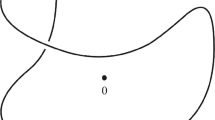Abstract
Kronecker's theorem is used to show that the irrational flows on then-dimensional torus are globally observed by a large class of continuous functions. These results are used to study the observability of Riccati flows on the Grassman manifolds.
Similar content being viewed by others
References
D. Aeyels, Global observability of Morse-Smale vector fields,J. Differential Equations,45 (1982), 1–15.
G. Ammar and C. Martin, The geometry of matrix eigenvalue methods,Acta Math. Appl. (to appear).
T. M. Apostol,Modular Functions and Dirchlet Series in Number Theory, Springer-Verlag, New York, 1976.
W. Boothby,An Introduction to Differentiable Manifolds and Riemannian Geometry, Academic Press, New York, 1975.
H. Bohr, Again the Kronecker theorem,J. London Math. Soc.,9 (1934), 5–6.
I. Cornfeld, S Fomin, and Ya. Sianai,Ergodic Theory, Springer-Verlag, Berlin, 1982.
L. Drager and C. Martin, Global observability of a class of nonlinear discrete time systems,Systems Control Lett.,6 (1985), 65–68.
R. Herman and C. Martin, Lie and Morse theory for periodic orbits of vector fields and matrix Riccati equations, I,Math. Systems Theory,15 (1982), 277–284.
R. Herman and C. Martin, Lie and Morse theory for periodic orbits of vector fields and matrix Riccati equations, II,Math. Systems Theory,16 (1983), 297–306.
G. H. Hardy and E. M. Wright,An Introduction to the Theory of Numbers, Oxford University Press, London, 1962.
R. Kalman,Lectures on Controllability and Observability, Centro Internazionale Mathematico Estivo Summer Course 1968, Cermonese, Rome.
L. Kronecker, Näherungsweise genzzahlige Auflösung Linearer Gleichungen, S.-B. Preuss. Akad. Wiss., (1984) [Werke, iii (i), 47–110].
N. Levitt and H. Sussman, On controllability by means of two vector fields,SIAM J. Control Optim.,13, (1975), 1271–1281.
E. Sontag,Polynomial Response Maps, Lecture Notes in Control and Information Sciences, Springer-Verlag, New York, 1979.
M. Shayman, Phase portrait of the matrix Riccati equation,SIAM J. Control Optim. (to appear).
Author information
Authors and Affiliations
Additional information
Supported in part by NASA Grant # NAG 2-203.
Rights and permissions
About this article
Cite this article
Drager, L., Martin, C. Global observability of flows on the torus: An application of number theory. Math. Systems Theory 19, 103–115 (1986). https://doi.org/10.1007/BF01704909
Received:
Revised:
Issue Date:
DOI: https://doi.org/10.1007/BF01704909



